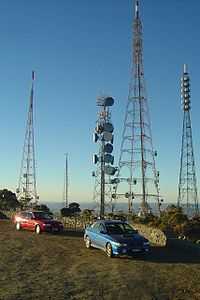Mount Canobolas
| Mount Canobolas | |
|---|---|
 Mount Canobolas from the Pinnacle. | |
| Elevation | 1,395 m (4,577 ft)AHD |
| Location | |
| Location | New South Wales, Australia |
| Coordinates | 33°20′39″S 148°58′57″E / 33.3442°S 148.9824°ECoordinates: 33°20′39″S 148°58′57″E / 33.3442°S 148.9824°E |
| Climbing | |
| Easiest route | Drive |
Mount Canobolas, at an elevation of 1,395 metres (4,577 ft) above sea level, is the highest mountain in the central tablelands district of New South Wales, Australia.
The mountain is of volcanic origin. It is located 13 kilometres (8 mi) southwest of the city of Orange, and it is about 250 kilometres (155 mi) west of Sydney.
The northern slopes of the mountain, with fertile volcanic soil, are becoming a popular cold-climate wine producing area.
The name comes from two Aboriginal words, 'coona' and 'booloo' meaning two headed beast or conjoined twins. There is a 360 degree view from the summit, which is often snow-capped in winter. The mountain is now part of a 15 square kilometre area controlled by the National Parks and Wildlife Service, which offers various walks: to Bald Hill; to Young Man Canobolas; Federal Falls to Mount Towac, etc.[1] The volcanic peaks give wide views and there are some attractive waterfalls. The mountain was first climbed by a European when Major Thomas Mitchell came there in 1835. An early squatter on the slopes of the Canobolas Range was Thomas Hood, whose father, John Hood, came from England for a visit in 1841, and wrote an account of the district. By 1848 Hood was lessee for Boree Cabonne.
The top of the mountain is now dominated by numerous towers used for television and radio transmissions across large areas of central New South Wales. These transmitters include towers for Airservices Australia, Royal Australian Air Force, Prime Television, WIN Television, Australian Broadcasting Corporation and Southern Cross Ten.
Each year the Orange Community runs the Great Volcanic Mountain Challenge, an 11 km walk and fun run from the Pinnacle to the Summit of Mount Canobolas by the volcanic plugs of Mount Towac and Young Man Canobolas. The inaugural event was held in 2006.[2]
Geology and Landscape
Mount Canobolas is an extinct volcanic complex which erupted in several phases between 13 and 11 million years ago, making the mountain a relatively recent geological feature. Earlier eruptions were less violent with free flowing lavas reaching a maximum coverage extent of approximately 800 square kilometres. Later eruptions became more violent, and producing increasingly viscous lavas with less extensive coverage.
The contemporary landscape of Mount Canobolas exhibits erosional features dominated by several remnant peaks. Additional volcanic features are present within the zone of volcanic influence, including vents, dykes, peaks, domes and plugs.
The mountain's geologic history has yielded a variety of landforms which provide a range of environmental habitats, and notably rocky outcrops harbouring rare species of lichens. There are cliff features with waterfalls, such as the popular recreation locality, Federal Falls. Mount Canobolas is listed on the Register of the National Estate because of its geological significance.[3]

Highest Point claims
Mount Canobolas is, as claimed, the highest point in New South Wales west of the Great Dividing Range, but is not, as is sometimes claimed, the highest point between Australia's Great Dividing Range and Africa, with both Mount Zeil in Australia's Northern Territory and Mount Woodroffe in South Australia being higher, at 1,531 metres and 1,435 metres, respectively. This would in any case be an insignificant claim to fame, since many of the tallest peaks in the Great Dividing Range are in fact further west than Mount Canobolas is. For example, Mount Bogong in Victoria at 1,986 metres and 36°44′S 147°18′E / 36.733°S 147.300°E is 591 metres higher and almost a degree and a half longitude further west. This translates to a difference of around 125 kilometres using the degree length formula.
The islands of Réunion and Madagascar also have higher peaks and are between the Great Dividing Range and Africa.
See also
References
- ↑ Mount Canobolas State Conservation Area Department of Environment and Climate Change NSW. Accessed May 5, 2007
- ↑ Runners facing uphill challenge - Course as tough as ever: Davis Central Western Daily 24 March 2007. Accessed May 5, 2007
- ↑ "Mount Canobolas State Conservation Area". NSW Government. Retrieved 9 June 2014.